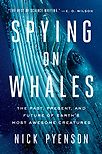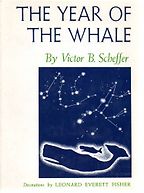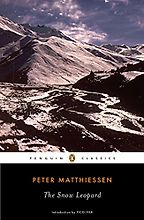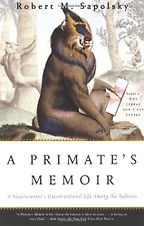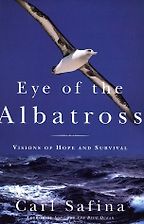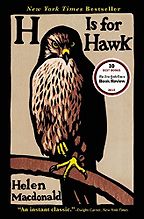Why choose books about predators?
Quite simply, they haunt us. For most people on the planet, the predators that stalked our ancestors have been marginalised to the brink of extinction. Bears, big cats, and wolves are effectively ecological ghosts. Maybe you’ve seen one pace at a zoo, or heard coyotes wail on the edges of suburbia and farmland. But the real things still awe us, even if they can’t hurt us, and that emotion leads to a particular kind of fascination because there’s so much that’s unknown about creatures that may want us for lunch. David Quammen, of course, said all of this much better in his book Monster of God. But there are many predators on other branches of the tree of life that aren’t the man-eating kind, so I think it’s worth expanding our minds with considering these others too.
It turns out, too, that predators matter a whole lot to the structure and function of food webs—to ecological complexity and abundance. So if we’re interested in knowing which parts of the planet we need to preserve in the coming centuries in order to survive—that’s, essentially, E O Wilson’s Half-Earth in a nutshell—then following the tracks of predators might be a good start.
Your book Spying on Whales is about the past, present and future of whales, but as a curator of fossil marine mammals your focus is largely on the past. What made whales the predators they had become by the time humans appeared on the scene?
There are two levels of answer to this question. First, the easy level: whales have always been predators because of their history. Whales descend from land-dwelling ancestors that had sharp, blade-like teeth for eating meat—even though they are related to hoofed mammals. As I write in my book, things were weird back in the Eocene. Whales never lost that carnivorous diet, the same way that sea cows never stopped being herbivorous. It’s definitely part of the puzzle for studying evolution: there seems to be some kinds of ways of living that are hard to break, or at least switch rarely. Being carnivorous let whales expand from rivers and deltas to oceans, pole to pole, over the course of evolutionary time.
“Whales descend from land-dwelling ancestors that had sharp, blade-like teeth for eating meat”
The second level is nearer in time: whales have a disproportionate impact on food webs because of their size—they’ve evolved to become top consumers, with huge physiological demands, in every food web they’ve encountered, be it nearshore, out at sea, or in rivers. By the time humans evolved, whales had been the brainiest mammals (as measured from brain size to body size) on the planet for at least five million years, if not ten. Killer whales had already evolved, and sperm whales definitely plied the oceans. Rorqual whales got very, very large during the same time that humans evolved, so in many respects, our own lineage evolved in the shadow of these giants—but these giants never caused any real harm to humans, tales of Job notwithstanding. Whales alive in the ocean or stranded on the shore have probably always inspired awe for humans; it’s not so surprising, when you catalogue the amazing traits of whales, that they have always been the stuff of myth.
A recent study has found that many killer whales have concentrations of PCBs in their bodies around a hundred times the safe level, and predicted that about half of all that remain in the world are likely to die from this. I have also recently read a striking and distressing article about the lives and prospects for right whales. Your book starts with a note of hope, however. Some whale species in the Southern Ocean and around Antarctica seem to be recovering from the mass slaughter of the twentieth century. Is there hope for whales? If so, which species have the best prospects?
The article on right whales to which you refer is thorough, accurate, and nuanced. It is necessary reading about the ongoing crisis facing this species, which made it through nearly a millennium of whaling, only to now live in an ocean where other human activities cause constant suffering. For killer whales the challenges vary. In the North Pacific, for instance, one kind, or ‘ecotype’ are exclusively fish-eating residents along the coast of North America. They suffer because we have cut off their favoured prey source—the salmon runs. By contrast, transient killer whales, which prefer to eat mammals such as seals, suffer those same incredibly high concentrations of toxins described in the Scottish example, harming them in ways that we barely know. The spotlight is bright on these whale species, and that’s a good thing. But we’re forgetting that there’s many others that are on the brink of extinction, and like the vaquita, are, perhaps, slipping away.
These awful stories should be read in tandem with stories of success. Conservation measures, when implemented in a timely and effective manner, have given hope for the fate of many whale species. Humpback whales were delisted from the US endangered species list in 1994, and grey whales seem to be making incursions into the Atlantic, an ocean they haven’t been in for over 400 years. In both of those cases, the cessation of whaling has contributed to their success, but their broad diet and geographic range, along with some aspects of their life history, have also been important factors. We don’t always know what will work, and there are certainly going to be surprises, especially with the risks presented by global climate change.
“Whales today tell us so much more about the impact of our lives on the rest of the world than we realise”
What I would say is that whales today tell us so much more about the impact of our lives on the rest of the world than we realise. One of the biggest threats to the right whales mentioned in Mackinnon’s essay is noise from human activity. This is, or has been, imperceptible to us and removed from our experience. We also really don’t have any understanding of what ocean plastic are doing to cetaceans, besides the fact that they sometimes swallow plastic bags. It may well be that they’re integrating micro-plastic particles into their tissues. How much, and what are the effects on their health? We have no clue. We really should figure that out, for the seafood we do eat (and share with whales). Knowing about whales will tell us so much more about the scale of our impact and our adaptability to living on Anthropocene Earth.
Your first book choice is The Year of the Whale by Victor Scheffer. This was first published nearly 50 years ago. What makes it relevant today?
Scheffer wrote his book at a crucial juncture in our understanding of whales in the twentieth century, during the late 1960s, when whales shifted from objects of industrial-scale pursuit to subjects of inquiry, adulation, and awe. As a marine mammalogist himself, Scheffer was well aware of the vast scale of industrial whaling and its devastation at the time—we now know close to three million whales were killed during the twentieth century. The book’s publication only precedes the landmark US Marine Mammal Protection Act by a few years. Federal protection and quick curtailing of industrial whaling coincided with waves of discoveries about the lives of whales—from whale-song and the amazing echolocation sensory abilities of toothed whales—that moved whales into public awareness as organisms almost like us, but with seemingly mystical abilities. Scheffer’s narrative presages these advancements in a real way.
The Year of the Whale was also an innovative narrative conceit: a fictional account of the year-long journey of a single sperm whale calf, but blended strongly with facts that Scheffer knew about sperm whales as a scientist, and how they navigate their world, full of encounters with other marine life, and abundant human threats. While sperm whales are no longer under any immediate threat from whaling, many of the human threats such as ship-strike, pollution and net entanglement, continue. Scheffer’s book, and its aesthetic execution also strongly influenced my book. The simple art pieces by Leonard Everett Fisher bookending each chapter has a direct lineage from Rockwell Kent’s woodcut illustrations for the 1930 edition of Melville’s Moby-Dick. I like the approach; we want to tug at the mystery, without revealing all of it, because that admits that there’s so much we don’t really know.
Your second choice, Peter Matthiessen’s The Snow Leopard, is widely considered a classic. What makes the book stand out for you?
First, Matthiessen’s book defies easy description. Seeking snow leopards is certainly the primary driver of the narrative, but there’s so much more because underlying throughlines contribute in major ways to making the book so different from the standard travelogue. The basic conceit is Matthiessen’s description of his travels in the Tibetan Plateau alongside George Schaller, who was a leading mammalogist at the time. In that way, The Snow Leopard feels like it should fit into the same science travelogue canon as Humboldt and Darwin—but it’s clearly more than that because of what Matthiessen brings to the story. In other words, it’s not really just about snow leopards—or Himalayan blue sheep, the other mammal that Matthiessen and Schaller sought.
Get the weekly Five Books newsletter
The book stands apart and it remains fresh because of the ways that Matthiessen weaves his exploration of the outer world with his own inner one. Both are arduous, in foreboding landscapes, and Matthiessen’s shared quest to find elusive mammals happens at the same time that the reader learns so much about Matthiessen himself: the grief of losing his spouse, his adoption of Zen Buddhism, and the guilt from being an absent parent. As an aside, I explicitly borrowed from Matthiessen’s style of father-son correspondence in the opening chapter of my book. When you gather all of Matthiessen’s throughlines, it’s clear that The Snow Leopard is not a typical travelogue, especially because the narrator’s inner life shines through in ways that other similar books do not—In Patagonia, for example, tells us little about Chatwin’s own remarkable personal life. I think what Matthiessen does so well in this book is keep us on the long quest because of the intimacy and trust that he builds with the reader. The process is satisfying because Matthiessen reveals so much about who he is, even if the predator in question remains elusive.
More is known about snow leopards today than it was in the 1970s when Matthiessen wrote his book. They are less mysterious now. Does that make them less fascinating?
Well, perhaps slightly less mysterious. I think there’s this impression today that most of the natural world is, in effect, known. In this view, it seems remarkable that we don’t know all that there is to know about the world’s big cats, or other predators. Scientists intuitively know that this impression in unfounded: the wild lives of most species really are not that well known. In the 40 years since the publication of Matthiessen’s book, we definitely do know a lot more about snow leopards. But basic questions—such as how many are there, exactly, in the world?—remain guesses.
I think zoos and natural history films have a way of trivialising predators, turning them into near-caricatures, scripted for short attention spans—the great humorist Jon Mooallem wrote a bit about this reduction in his book Wild Ones. We rarely see predators in their habitats because they’re fundamentally hard to study—even urban ones, such as coyotes and mountain lions are nocturnal. Instead, we’re left with whatever naturalists can tease and pull out, documentation wise, from going out and finding them.
“Zoos and natural history films have a way of trivialising predators, turning them into near-caricatures, scripted for short attention spans.”
But the hard work of a field biologist remains irreducible. The ways we can know about predators still amounts to finding them, camera trapping them, tracking them—spying on them, as it were. And most predators, because of their body size, ecological position, and various legacies of human hunting, remain tremendously at risk for extinction. Not all species are equal, and we need to care a lot more about the survival of ecological keystones—wolves, sea otters, and the like—because those species have disproportionate effect on food webs relative to their abundances. How many other keystones will we lose without knowing? That’s one of the great unknowns about conservation in the Anthropocene.
Your third choice is A Primate’s Memoir by Robert Sapolsky. The predator at the centre of this book is the baboon. Or is it, perhaps, the human?
That question is, effectively, Sapolsky’s impish humour at work. It’s sometimes not clear if his pen is aimed at baboons or at us. There’s good reason for that ambiguity, of course, because we share a common ancestor with baboons; a lot of similarities that we see in their behaviour, from grooming, to dominance displays, to foraging habits, have to do with our shared evolutionary history. But baboons don’t write books, so a gifted storyteller has the upper hand on this point. Sapolsky’s book is my favourite in the modern scientist-author canon. It was a template for my own book because so much of the story about figuring out his troop of baboons in Kenya was really a story about Sapolsky’s own scientific career. He places you in his shoes, and shows you how his ensemble cast of baboons (generations of them, actually) have personality, agency, and succumb to the same foibles that we do.
At the same time, Sapolsky doesn’t downshift the science, and gives the reader the how and the why of understanding their social networks via study of their blood biochemistry). At no point do you feel like you’ve been misled, or been given a cliched misadventure—his stories are as authentic as they are laugh-out-loud funny. The healthy doses of humour in the book make you appreciate that scientists are both fun and funny, which few other books have done. And that you don’t need to worry too much about that primate that you see in the mirror. You’re safe in the hands of a peripatetic, twinkly-eyed guide, who you can trust with your most intimate questions about the planet’s top predator.
Tell us about your fourth choice, Carl Safina’s Eye of the Albatross.
Safina is both a storyteller and a scientist, just like Sapolsky, but Safina’s work really pulls at the heart of conservation: what do we know about what we want to protect? And why should we do so? Those questions, to the uninitiated, seem portentous and diffusely broad, but Safina’s books have a way of grounding them in a love for knowing the organism, which in turn teaches us about the bigger picture.
Seabirds are predators just like big cats and primates, but unless you live on a coast they tend to be out of sight, out of mind. Superlatives help with any argument, and albatrosses are a good picks for seabird maxima, for so many reasons: not just as largest living flying organism, they also have lives spent soaring across oceans in search of their prey on a single flap, riding wind off the waves—at scales not unlike some whales, although albatrosses must return to land, at some point, to raise their young.
Safina picks a smart path in following the life of a very specific Laysan albatross named Amelia. Large albatross species can live decades, and the long temporal and vast geographic scales of her life lets Safina examine, for example, the pervasive fingerprints of human pollution, even in the most remote places on the planet. By individuating the predator, Safina makes these otherwise strange species relatable—almost like characters pulled from fiction—much as Scheffer did with a fictional whale, or Sapolsky did in aggregate with his troop of baboons. Breathing life into other species, in narrative form, is a tricky thing to do without anthropomorphising, and I think Safina does this so well; and again, keeping some of the mystery because other organisms besides us may be ultimately inscrutable, despite our dogged attempts to know them.
Anthropomorphising other animals has long been a no-no for scientists and others who want to be taken seriously in our culture. But isn’t there also a danger in not recognising how close to our own emotions and behaviour those of other species can sometimes be?
This, or something like it, is one of the points that, for example, Frans de Waal highlights in Are We Smart Enough to Know How Smart Animals Are? and Carl Safina himself emphasises in Beyond Words: What Animals Think and Feel.
I think of anthropomorphism as an ugly outgrowth of narcissism coupled with unimaginative thinking—not so much a statement on the subjects as it is about us: when it happens, it betrays a failure of our own observational and critical thinking abilities.
Serious thinking about the nature of emotion and behaviour in non-human species goes back to Darwin, who recognised that they were worth attention. And I agree that in recent years we’ve seen a sea-change in how we talk about the inner minds and emotional states of animals, especially predators, be they crows, primates, or whales. What we really want to know is, what’s going on behind all of those remarkable behaviours? Or, as I wrote in my book, borrowing from a conversation that I had with one of my mentors, the neuroscientist Lori Marino, “Who are they?” I think individuating these animals is absolutely the start of figuring them out. We’re not anthropomorphising when we’re learning about Amelia’s fidelity in Safina’s book, or Nebuchadnezzar’s laziness in Sapolsky’s.
“I think of anthropomorphism as an ugly outgrowth of narcissism coupled with unimaginative thinking”
When you read de Waal or Safina’s books—or if you’ve had the opportunity to have prolonged encounters with super smart species—it’s clear that the empiricists have, at the very least, made the case that there is a mind behind those eyes. And sometimes, for some species, that mind shows what we would call joy, grief, and an understanding of mortality. I think the scientific questions get really interesting, however, when you consider history and context. While it may not be so surprising that other primates share our suite of emotions because of our shared evolutionary history, whales are certainly displaying behaviours unlike their nearest, terrestrial, relatives. Does that have something to do with ocean environments, and their scale or complexity? Comparative biology provides a framework for entangling these issues with predators. It’s an exciting time to be a scientist.
Your final choice is H is for Hawk by Helen Macdonald. Why do you recommend this book?
Just as The Snow Leopard isn’t entirely about its titular predator, the raptor in Macdonald’s book is essentially a foil for a broader essay on grief. But raptors are certainly revealed in H is for Hawk. Macdonald’s descriptions and experiences raising goshawks are intimate, full of details that animate the focal predator as much as Sapolsky’s baboons. In other words, raptors have character in H is for Hawk. They are also, in fact, characters in the book: Macdonald gives her particular goshawk the name Mabel. I think Macdonald’s take on Mabel and her kin is surprising to most people because we tend to extol mammalian predators, which are most like us, over the scaly and feathery ones, which are more unlike than like.
Five Books interviews are expensive to produce. If you're enjoying this interview, please support us by donating a small amount.
What happens in H is for Hawk is that raising a goshawk is an education for Macdonald; forging a connection across predators that are very distantly alike involves setbacks, insights, and achievements like any other learning experience. It’s also, of course, a way for Macdonald to process the grief of her father’s sudden death. That strong parallel is so much like to first person narratives of great science writing. While Macdonald isn’t a workaday scientist, her journey fits into the same universe of experiences from Matthiessen to scientist-authors such as Sapolsky.
To me, the most striking aspect of this book is how an otherwise wild animal lived within domestic confines—Mabel occupied a place in Macdonald’s home anytime they weren’t tromping in a wood. That image is a hard one to substitute with a primate or a whale; even a crow would seem ill-advised as a roommate. But Macdonald never marginalised Mabel’s wildness; it was an idea that dominated most every aspect of their shared experience. The result is a text that is heavy with respect for that distance between us and other species—a distance that can be harrowing, perplexing, and a source of solace. I think what makes a book about predators durable is the degree to which the author successfully wrestles with that fundamental problem. H is for Hawk feels like the definitive statement on hawks for the modern times, and I think its success has a lot to do with how well Macdonald tied her inquiry into the life of a hawk with her own personal experience and journey.
Five Books aims to keep its book recommendations and interviews up to date. If you are the interviewee and would like to update your choice of books (or even just what you say about them) please email us at [email protected]

